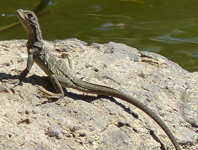Abstract
The present work describes and illustrates in detail the six zoeal stages of Albunea paretii collected from plankton samples on the Amazon continental shelf in Brazil. The morphological characters are compared with those of other known albuneid larvae. As in other albuneids, the zoeae of Albunea paretii have a semi-globose carapace, a long rostral spine and a pair of long posterolateral spines on pereon, as well as three aesthetascs on the antennule of zoea I, a strong antennal spinous process and a convex telson with a stout posterolateral spine. The zoeal morphology of Albunea paretii and other species of the genus differs, especially regarding the unique presence of the posterolateral spine only on the 5th pleonite in zoea I–IV and the absence in later zoeal stages. The differing features of the albuneid subfamilies are in the telson, antenna and maxilla format and number of setae.
References
Anger, K. (2001) The biology of decapod crustacean larvae. Crustacean issues, Zoological Museum, University of Amsterdam, Amsterdam, 404 pp.
Barros, M.P. & Pimentel, F.R. (2001) A fauna de Decapoda (Crustacea) do Estado do Pará, Brasil: lista preliminar das espécies. Boletim do Museu Paraense Emílio Goeldi, Zoologia, 17(1), 15–41.
Bartilotti, C., Calado, R. & Dos Santos, A. (2008) Complete larval development of the hermit crabs Clibanarius aequabilis and Clibanarius erythropus (Decapoda: Anomura: Diogenidae), under laboratory conditions, with a revision of the larval features of genus Clibanarius. Helgoland Marine Research, 62, 103–121.
https://doi.org/10.1007/s10152-007-0079-2
Boyko, C.B. (2002) A worldwide revision of the recent and fossil sand crabs of the Albuneidae Stimpson and Blepharipodidae, new family (Crustacea: Decapoda: Anomura: Hippoidea). Bulletin of the American Museum of Natural History, 272, 1–396.
https://doi.org/10.1206/0003-0090(2002)272<0001:AWROTR>2.0.CO;2
Boyko, C.B. (2010) New records and taxonomic data for 14 species of sand crabs (Crustacea: Anomura: Albuneidae) from localities worldwide. Zootaxa, 2555 (1), 49–61.
https://doi.org/10.11646/zootaxa.2555.1.3
Boyko, C.B. & McLaughlin, P.A. (2010) Annotated Checklist of Anomuran Decapod Crustaceans of the world (exclusive of the Kiwaoidea and families Chirostylidae and Galatheidae of the Galatheoidea). Part IV—Hippoidea. Raffles Bulletin of Zoology, Supplement No. 23, 139–151.
De Grave, S., Pentcheff, N.D., Ahyong, S.T., Chan, T-Y., Crandall, K.A., Dworschak, P. C.D., Felder, L., Feldmann, R.M., Fransen, C.H.J.M., Goulding, L.Y.D., Lemaitre, R., Low, M.E.Y., Martin, J.W., Ng, P.K.L., Schweitzer, C.E., Tan, S.H., Tshudy, D. & Wetzer, R. (2009) A classification of living and fossil genera of decapod crustaceans. Raffles Bulletin of Zoology, Supplement 21, 1–109.
Garm, A. (2004) Revising the definition of the crustacean seta and setal classification systems based on examinations of the mouthpart setae of seven species of decapods. Zoological Journal of the Linnean Society, 142, 233–252.
https://doi.org/10.1111/j.1096-3642.2004.00132.x
Gore, R.H. & Van Dover, C.L. (1981) Studies on decapod Crustacea from the Indian River region of Florida. XIX. Larval development in the laboratory of Lepidopa richmondi Benedict, 1903, with notes on larvae of American species in the genus (Anomura: Albuneidae). Proceedings of the Biological Society of Washington, 93 (4), 1016–1034.
Gurney, R. (1942) Larvae of Decapod Crustacea. Ray Society, London, 306 pp.
Johnson, M.W. & Lewis, W.M. (1942) Pelagic larval stages of the sand crabs Emerita analoga (Stimpson), Blepharipoda occidentalis Randall, and Lepidopa myops Stimpson. Biological Bulletin, 81, 67–87.
https://doi.org/10.2307/1538014
Knight, M.D. (1970) The larval development of Lepidopa myops Stimpson, (Decapoda, Albuneidae) reared in the laboratory, and the zoeal stages of another species of the genus from California and the Pacific coast of Baja California, Mexico. Crustaceana, 19 (2), 125–156.
https://doi.org/10.1163/156854070X00464
Kurata, H. (1970) Studies on the life histories of decapod Crustacea of Georgia: Part III. Larvae of decapod Crustacea of Georgia. Final Report University of Georgia Marine Institute, Sapelo Island, 274 pp.
Melo, G.A.S. (1999) Manual de Identificação dos Crustáceos Decapoda do Litoral Brasileiro: Anomura, Thalassinidea, Palinuridea e Astacidea. Plêiade/FAPESP, São Paulo, 551 pp.
Menon, M.K. (1937) Decapod larvae from the Madras plankton. Bulletin of the Madras Government Museum, n.s., Natural History Section, 3 (5), 1–56.
Oliphant, A., Hauton, C. & Thatje, S. (2013) The Implications of Temperature-Mediated Plasticity in Larval Instar Number for Development within a Marine Invertebrate, the Shrimp Palaemonetes varians. PLoS ONE, 8 (9), e75785.
https://doi.org/10.1371/journal.pone.0075785
Sanchez R., S.G. & Aguilar F., P.G. (1975) Notas sobre crustaceos del mar Peruano – I: Desarrollo larvario de Lepidopa chilensis Lenz (Decapoda, Anomura: Albuneidae). Anales Científicos, 13 (1 & 2), 1–11.
Sandifer, P.A. & Van Engle, W.A. (1972) Lepidopa larvae (Crustacea, Decapoda, Albuneidae) from Virginia plankton. Journal of the Elisha Mitchell Scientific Society, 88, 220–225.
Sanvicente-Añorve, L., Rubio, S., Lemus-Santana, E., Allende-Arandía, E. & Zavala-Hidalgo, J. (2019) Distribution of Hippoidea (Decapoda, Anomura) larvae off Veracruz, southern Gulf of Mexico: inferences about their migration route. Crustaceana, 92 (5), 585–597.
https://doi.org/10.1163/15685403-00003889
Seridji, R. (1988) Some planktonic larval stages of Albunea carabus (L., 1758) (Crustacea, Decapoda, Anomura). Journal of Natural History, 22 (5), 1293–1300.
https://doi.org/10.1080/00222938800770791
Stuck, K.C. & Truesdale, F.M. (1986) Larval and early postlarval development of Lepidopa benedicti Schmitt, 1935 (Anomura: Albuneidae) reared in the laboratory. Journal of Crustacean Biology, 6 (1), 89–110.
https://doi.org/10.1163/193724086X00758
Tudge, C.C., Asakura, A. & Ahyong, S.T. (2012) Infraorder Anomura Macleay, 1838. In: Schram, F.R. & von Vaupel Klein, J.C. (Eds.), Treatise on Zoology—Anatomy, Taxonomy, Biology—The Crustacea, Decapoda. Vol. 9. Part B. Eucarida: Decapoda: Astacidea P.P. (Enoplometopoidea, Nephropoidea), Glypheidea, Axiidea, Gebiidea, and Anomura. Brill, Leiden, pp. 221–333.
https://doi.org/10.1163/9789047430179_005
Yeung, C., Criales, M.M. & Lee, T.N. (2000) Unusual larval abundance of Scyllarides nodifer and Albunea sp. during an intrusion of low-salinity Mississippi flood water in the Florida Keys in September 1993’ Insight into larval transport from upstream. Journal of Geophysical Research, 105 (12), 28741–28758.
https://doi.org/10.1029/1999JC000269

